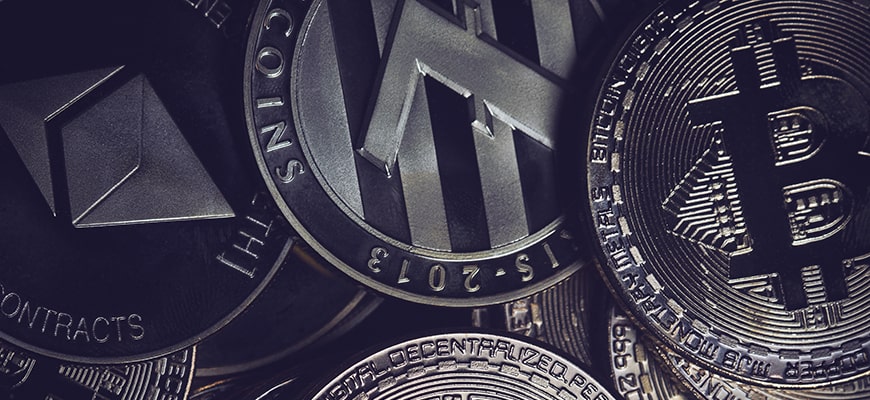Binance vs. Coinbase: Which Should You Choose?
Cryptocurrency exchanges is the best option for buying digital coins due to the following advantages of exchanges: the best rate, high liquidity, the possibility to buy crypto with fiat, different payment methods and so on.
Crypto Exchanges Binance and Coinbase are prominent participants in the crypto market. Binance is the world leader in trading volume, Coinbase is also one of the TOP exchanges by capitalization.
Binance
Binance is one of the fastest growing cryptocurrency exchanges and the leader in daily trading volume. In addition to trading on different markets, there are other ways to make money on crypto on Binance, such as staking, deposits, loans and so on.

Basic information about Binance:
- Founding year: 2017;
- Founder: Changpeng Zhao;
- Verification: required;
- Trading pairs: 1400+;
- Available markets: spot, derivatives, purchasing by card, P2P, OTC, margin trading, NFT;
- Trading fees: up to 0,1%.
Coinbase
Coinbase is a multifunctional platform with large trading volumes and wide functionality. The platform actively develops partnerships with large companies and offers exclusive solutions for institutional clients and developers.

Basic information about Coinbase:
- Founding year: 2012;
- Founders: Brian Armstrong, Fred Ehrsam;
- Verification: required;
- Trading pairs: 550+;
- Available markets: spot, derivatives, purchasing by card, NFT;
- Trading fees: 0 – 0,4% for makers and 0,05 – 0,6% for takers, (stablecoin pairs – 0% for makers and 0,001% for takers.
Binance vs. Coinbase Fees
The amount of fees plays an important role when choosing a trading platform: the lower they are, the more profit the user makes. Consider the conditions of charged fees on both sites:
Binance Fees
Deposit: Crypto – no fees, Fiat – depends on the coin and method of replenishment;
Withdrawal: Depends on coin and withdrawal method (e.g., 0,29 – 3,55 USDT when withdrawing USDT on the ERC20 network, or 0,0000044 – 0,0002 BTC, when withdrawing bitcoins on the BEP20 network);
Trading commissions:
- Spot market: from 0,1% for makers and takers (or 0,075% if trading fees are paid in BNB) and zero fees on BUSD pairs and selected fiat/BTC and stablecoin/BTC pairs;
- Futures: USDⓈ-M Futures – 0,02% for makers and 0,04% for takers (minus 10% when trading fees are paid in BNBB), COIN-M Futures – 0,01% for makers and 0,05% for takers.
Coinbase fees
The fees charged by the platform are not fixed. They are expanded only during the transaction. The fees are based on the exchange’s own estimate of the prevailing network fees and are billed on a per-transaction basis.
The final commission paid by the user Coinbase, may differ from the calculated one (for example , due to the fact that the transaction will be merged with other transactions or due to a change in the level of network congestion).
Binance vs. Coinbase Fees Comparison Table
| Commission | Binance | Coinbase |
|---|---|---|
| Deposit/Withdraw fiat from the card | 1,8%; | No information; |
| Fiat top-up via a third-party EPS | For USD: via Simplex – 2,5% per transaction for EEA users and 3,5% per transaction for users from other countries; via Banxa – 1,99% per transaction; |
No information; |
| Fiat top-up by bank transfer | 0 – 1 euro (withdrawal methods and conditions depend on the user’s currency and country of residence); | 10 USD (Wire), 0,15 EUR (SEPA); |
| Crypto replenishment | 0%; | 0%; |
| Spot Trading Commission | 0,02% – 0,1% for makers and 0,04% – 0,1% for takers (25% discount when paying with BNB);
0% for BUSD pairs and individual fiat/BTC and stablecoin/BTC pairs; |
0% – 0,4% for makers and 0,05% – 0,6% for takers;
Stablecoin pairs: 0% for makers and 0,001% for takers; |
| Derivatives Trading Commission | USDⓈ-M Futures – 0,02% for makers and 0,04% for takers (-10% when paying BNB), COIN-M Futures – 0,01% for makers and 0.05% for takers; | From $0,07 to $0,35 for makers (depending on futures contract); |
| P2P trading | P2P transaction fee is charged only from the maker (no fee is charged from the taker). Its size depends on the coin (for example, 0,35% for USD and 0% for EUR); | Not supported; |
| Options trading | 0,02% for regular users and 0% for VIP makers and 0,015% for VIP takers; | Not supported; |
| Swap farming | 0,02% for regular users and 0% for VIP makers and 0,015% for VIP takers; | Not supported; |
| Staking fee | Not charged; | Coinbase Prime bills 10% of earned rewards monthly after rewards are paid out; |
| Mining fee | Binance Pool commission rate is 2,5% (VIP status with reduced commission rates for high hash rate users). | Not supported. |
Binance vs. Coinbase: Features
Let’s compare the opportunities that both platforms offer to users.
Binance Unique Features
Binance is a cryptocurrency platform that acts as an intermediary in cryptocurrency trading. It connects buyers with sellers and enables Crypto/Crypto and Crypto/Fiat transactions in the spot market. There are 1400+ trading pairs on the spot market.
Binance is also opening up access to derivatives trading. The exchange offers two types of futures contracts: COIN-Margined and USDS-Margined. Leverage on futures can reach x125).
Exchange users also have access to service for converting cryptocurrency. Using it you can instantly exchange digital assets directly in your wallet. 70+ cryptocurrencies, fiat currencies and stablecoins are available for swaping.
As for asset storage, Binance has its own crypto wallet – Trust Wallet. This is a mobile wallet that works on Android and iOS devices. Private keys are tied to the device, so only the user has access to them. The wallet can be used anonymously – verification is not required for this.

Coinbase Unique Features
Users of Coinbase can buy cryptocurrencies with national currencies. At the same time, fiat withdrawal to a card or PayPal is available.
Coinbase Wallet is a crypto wallet for storing cryptocurrencies and NFTs. The service supports a large number of assets and Dapp applications. Users can link their Coinbase account to their wallet and get quick and easy access to cryptocurrencies. The best industry security standards are applied to protect the funds.

Trading pairs
The list of supported currencies on Binance is much wider than one on Coinbase. But both platforms offer fiat pairs and allow you to withdraw fiat to the card.
Binance Supported Currencies
In addition to large trading volumes, Binance has a variety of supported assets. Exchange users can use 1400+ trading pairs, including fiat pairs. Among the available currencies are TOP coins and new tokens that are just entering the market. The exchange is regularly updated with new assets: in the Announcement section on the site you can read which assets were added and when.
Coinbase Supported Currencies
The number of currency pairs on Coinbase is more modest – now there are more than 550. The list of supported cryptocurrencies is on the site. Fiat pairs are available on the Coinbase spot market.
KYC Requirements
Both exchanges – Binance and Coinbase – require mandatory identity verification for working. Let’s consider what requirements the user must fulfill in order to gain access to the full functionality of the platform.
Binance Verification Requirements
There are 2 levels of verification on Binance – basic (Verified) and advanced (Verified Plus).
Basic level requirements:
- Personal information;
- Government-issued ID;
- Face recognition procedure.
The table contains the opportunities that the user receives after passing through different levels of verification on Binance.
| Verified | Verified Plus | |
|---|---|---|
| Fiat deposit and withdrawal limits | $50K daily | $2M daily |
| Cryptocurrency deposit limit | Unlimited | Unlimited |
| Cryptocurrency withdrawal limit | 8M BUSD daily | 8M BUSD daily |
| P2P transaction limits | Unlimited | Unlimited |
| Other features | LPD/OTC | LPD/OTC/Binance card |
Coinbase Verification Requirements
The US law obliges Coinbase to collect the following personal data of its customers:
- First and last name;
- Date of birth;
- Residential address.
The user must also provide answers for the next questions:
- What will he use Coinbase for?
- What is the source of his funds?
- What type of employment he has?
- What volume of cryptocurrency does he plan to earn per year?
- What industry does he work in?
The next step is to provide ID card. You can use one of these documents instead:
- Passport;
- Driver’s license;
- National ID.
Select the type of document and upload it to the system (or use a webcam). Verification usually takes a couple of hours, after which you will receive an email with an update on the verification status.
Only after passing all the above steps, a new user of the exchange can start working.
Binance vs. Coinbase: Security
Binance and Coinbase are safe and secure trading platforms. Both exchanges pay great attention to the safety of user funds.
In October 2022, Binance successfully passed the audit of Mazars (an international audit, tax and advisory company). According to reserve reports, the exchange has enough assets to allow users to withdraw funds and secure leveraged positions.
Coinbase representatives also assure that customers’ assets are securely stored and protected. The platform regularly provides reserves reports for available products.
Binance Security Features
Security settings on Binance:
- Complex login password;
- Identity verification;
- Two-factor authentication;
- Binding a phone number;
- Email confirmations;
- Whitelist for withdrawals;
- Anti-phishing code;
- Third party applications that have access to the account;
- Device management;
- Track account activity.
Binance Exchange is registered in the Cayman Islands. As for regulation, the exchange has valid licenses from a number of European regulators: France, Italy, Lithuania, Spain, Cyprus, Poland. The exchange has also received permission to provide services in Kazakhstan and has a license to operate in Dubai and in other countries of the Middle East.
Coinbase Security Features
Security measures on Coinbase:
- Two-factor authentication (Security Prompt – native 2FA method);
- Hashing passwords using the bcrypt algorithm with a high crack factor;
- Enhanced account security;
- Account blocking when suspicious activity is detected;
- Proactive security notices.
The Coinbase exchange is registered in the United States and has licenses to carry out cryptocurrency activities in this country. In 2018, the exchange received a license from the UK regulator FCA and can officially conduct operations with digital currencies in the EU countries. In 2021, Coinbase became the largest public crypto company with a total capitalization of $7.9 billion.
Binance vs. Coinbase: Staking Rewards
In addition to the basic trading features that we have discussed above, both trading platforms offer the opportunity to receive passive income. One of the most popular ways to do this is staking.
Binance Staking
Binance started its staking service in October 2019. Now the exchange provides the option of DeFi staking (using smart contracts).
Binance offers two types of staking: fixed or flexible by time staking. In the first case, the assets are blocked for a certain period, which is set in advance, and you cannot get your coins back until the time will expire. With flexible locking, there is no end date for the holding period specified, and the user can withdraw the staked assets when he wants.
14 assets are available for staking on Binance: LTC, XRP, ETH, BTC, BUSD and others. Profitability depends on the coin and the type of staking: from 0,6% up to 5,39%.
Coinbase Staking
6 assets are currently available for staking on Coinbase: ALGO, ADA, ATOM, ETH, SOL, XTZ. The annual percentage yield depends on the staked coin and ranges from 1% to 5,75%.
Coinbase also offers cloud staking. It lies in the fact that users can receive rewards by placing bets on public validators or running their own. Cloud staking works on 25+ networks, including Cosmos, BNB, Polkadot and more.
Binance vs. Coinbase: Main Differences
| Binance | Coinbase | |
|---|---|---|
| Founding year | 2017 | 2012 |
| Licenses | yes | yes |
| Verification | Required | Required |
| Number of trading pairs | 1400+ | 550+ |
| Fiat Pairs | yes | yes |
| Available Markets | Spot, derivatives, quick buy from card, P2P, OTC, margin trading, NFT; | Spot, futures, NFT; |
| Spot Trading Commission | from 0,1% for all participants (or 0,075% if fees are paid in BNB);
Zero fees for BUSD pairs and selected fiat/BTC and stablecoin/BTC pairs; |
0 – 0,4% for makers and 0,05 – 0,6% for takers;
Stablecoin pairs: 0% for makers and 0,001% for takers; |
| Staking | DeFi staking with fixed and flexible locking; | Yes (+cloud staking); |
| Crypto wallet | Trust Wallet; | Coinbase Wallet; |
| Additional Services | Cryptocurrency conversion, liquidity farming, crypto loans, Launchpad, dual-currency investments, auto-investment, Binance Pool, Binance Pay, ETH 2.0, etc; | Tutorial rewards, DeFi Yield, loans, developer solutions; |
| Security settings | 2FA, phone binding, SMS notifications, withdrawal whitelist, anti-phishing code, etc; | 2FA (Security Prompt), password hashing, enhanced account security, account lockout when suspicious activity is detected, proactive security notifications, etc; |
| Exchange Hacks | yes | no |
| Coingecko rating | 10/10 | 10/10 |
FAQ
However, even the most trusted trading platforms can get hacked, which has happened to Binance a few times. We advise you not to use exchanges to store large amounts of coins, and immediately respond to any suspicious activity to the exchange support service.


Comments (0)










